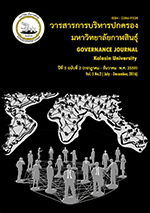การศึกษาเชิงอภิมานงานวิจัยเกี่ยวกับการบริหารจัดการทรัพยากร ป่าชุมชนในประเทศไทย
DOI:
https://doi.org/10.14456/gjl.2016.27คำสำคัญ:
การบริหารจัดการ, ป่าชุมชน, การอภิมาน, Management, Community Forest, Meta-Analysisบทคัดย่อ
การวิจัยครั้งนี้มีวัตถุประสงค์ คือ 1) วิเคราะห์คุณลักษณะงานวิจัยที่ เกี่ยวข้องกับการบริหารจัดการทรัพยากรป่าชุมชน 2) เพื่อสังเคราะห์องค์ความรู้ เกี่ยวกับการบริหารจัดการทรัพยากรป่าชุมชน 3) เพื่อศึกษาปัจจัยที่สัมพันธ์กับการ บริหารจัดการทรัพยากรป่าชุมชน 4) เพื่อเสนอข้อเสนอเชิงยุทธศาสตร์ในการบริหาร จัดการทรัพยากรป่าชุมชน โดยใช้วิธีการศึกษาเขิงอภิมาน งานวิจัยระดับบัณฑิตศึกษา ในช่วงปี พ.ศ.2533 – 2555 จำนวน 305 เรื่อง วิเคราะห์ข้อมูลด้วยสถิติพรรณนา ผลการวิจัย คุณลักษณะงานวิจัยในแต่ละเล่มสามารถสรุปได้ว่า ปีการศึกษาที่พิมพ์ เผยแพร่มากที่สุดคือ พ.ศ.2546 สถาบันการศึกษาที่ผลิตงานวิจัยมากที่สุดคือ มหาวิทยาลัยเกษตรศาสตร์ สาขาที่ผลิตงานวิจัยด้านนี้มากที่สุดคือ ส่งเสริมการเกษตร ปัจจัยที่มีความสัมพันธ์กับการบริหารจัดการทรัพยากรป่าชุมชนที่สำคัญ ได้แก่ ข้อมูล ลักษณะประชากร (เช่น เพศ, อายุ, อาชีพ, ระดับการศึกษา, จำนวนสมาชิกใน ครัวเรือน เป็นต้น) บทบาทภาครัฐ การใช้ประโยชน์จากป่า ความรู้ความเข้าใจเกี่ยวกับ ป่าชุมชน และสภาพป่า ตามลำดับ สำหรับวิเคราะห์ข้อมูล ด้วยวิธีการวิเคราะห์เนื้อหา พบว่า การบริหารจัดการทรัพยากรป่าชุมชน จะประสบความสำเร็จได้ต้องอาศัยความ ร่วมมือจากทุกภาคส่วนในพื้นที่ โดยอาศัยกระบวนการในการบริหารจัดการ 3 ขั้นตอน คือ การวางแผนดำเนินการ การดำเนินการ และการติดตามประเมินผล มี ข้อเสนอเชิงยุทธศาสตร์ 6 ข้อ คือ 1.ส่งเสริมการมีส่วนร่วมของประชาชนในการ บริหารจัดการทรัพยากรป่าชุมชน 2.การเสริมสร้างความเข้มแข็งขององค์กรชุมชน และการพัฒนาเครือข่าย 3.การสร้างความมั่นคงของฐานทรัพยากร ฟื้นฟู อนุรักษ์ 4. การพัฒนาคนเพื่อสร้างจิตสำนึกที่ดีในการอนุรักษ์และหวงแหนทรัพยากรที่ใช้ ประโยชน์ร่วมกัน 5.การบริหารจัดการทรัพยากรอย่างเป็นระบบโดยอาศัยความ ร่วมมือจากทุกภาคส่วน 6.การถ่ายทอดองค์ความรู้ในการบริหารจัดการและความ เข้าใจกฎระเบียบThe objectives of this research were to: 1) analyze the characteristics of research on community forest management; 2) synthesize knowledge about community forest management ; 3) study factors related to community forest management; and 4) to propose strategies for community forest management. This study was conducted by using meta-analysis. 305 graduate research published during 1990 – 2012 were investigated. The data obtained were analyzed by using descriptive statistics. The results of this study revealed that the characteristics of research on community forest management could be summarized as followed: most publications were published in the year 2003, Kasetsart University was the first leading producer of research publications, and most of research publications related to community forest management were produced by the Agricultural Extension Department. Regarding important factors related to community forest management, it was found that there were 5 important factors that included the demographic features (gender, age, occupation, education level, number of household members, etc.), roles of government sector, the use of community forest, knowledge about community forest, and forest condition. The data analyzed by using content analysis revealed that community forest management will be successful when all sectors in the area cooperated in 3 management processes that included planning, implementation, and evaluation. 6 strategies were proposed as followed: 1) promote people participation in community forest management; 2) strengthen the community organization and network development; 3) support the stability of resource base including restoration and conservation, 4) develop human resource by cultivating good conscience to conserve and take care of resources they mutually utilized, 5) operate resource management systematically through all sectors cooperation, and 6) transfer knowledge and rules about community forest management.
Downloads
ดาวน์โหลด
เผยแพร่แล้ว
รูปแบบการอ้างอิง
ฉบับ
ประเภทบทความ
สัญญาอนุญาต
ลิขสิทธิ์ (c) 2017 วารสารการบริหารปกครอง (Governance Journal)

อนุญาตภายใต้เงื่อนไข Creative Commons Attribution-NonCommercial-NoDerivatives 4.0 International License.








